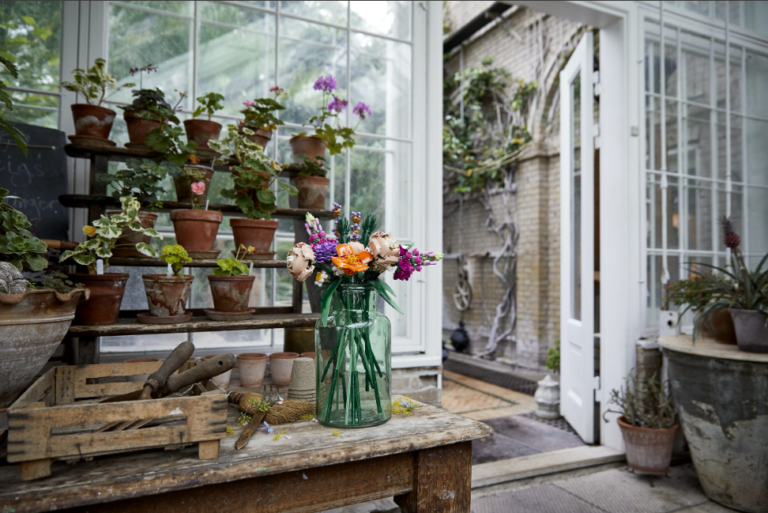How to Pillar Roses
Pillaring a rose is very simple and only takes periodic attention to keep it looking great. Basically, it is wrapping your rose around a post or upright structure barber pole style. This can be a post in the ground, a metal structure or even an old Pillar.
Here is Tess in mid-November, I let her go pretty wild as I knew I was going to do this demo for you. Lots of canes going everywhere but we are going to cut many of those back.
When should I pillar my rose?

Spring and early summer are one of the best times to pillar roses. The new growth is flexible and easier to train in the directions you desire. Once the canes begin to harden you are more limited in how to can bend them.
CLIMBING AND ‘PILLAR’ ROSES
Many climbing roses have over-large flowers on leggy stems, due to their old-fashioned Hybrid Tea blood. Their pliable stems are ideal for winding around a pillar before the new growth hardens, usually in October and November. This slows the sap and helps produce more flowers. The following two are exceptional ‘pillar roses’, not leggy monsters that need to be viewed from the bedroom window. ‘New Dawn’ (technically a repeat-flowering Rambler) is very healthy with perfectly-formed silver-pink flowers and neat, healthy foliage, while ‘Aloha’ has salmon-pink cabbage-like blooms that achieve perfection. ‘Aloha’ will never disappoint, so overcome the ugly Hawaiian name and plant it! A lot of David Austin roses can also be used as pillar roses too, including the buff-yellow ‘Graham Thomas’, the cream-white ‘Claire Austin’ and the glowing-pink ‘Gertrude Jekyll’.
You can also defy gravity (another way of slowing sap flow and getting more flowers), by pulling rose stems downwards, or by looping ramblers along the fence to produce arching shapes rather like a looper caterpillar in motion.
There are some repeat-flowering ramblers, but they tend to be shorter and less vigorous. ‘Phyllis Bide’ bears small salmon-pink flowers, but she’s thorny so position her carefully away from paths. Less thorny and with more apricot than pink flowers is the lovely ‘Ghislaine de Féligonde‘, a rose with very glossy foliage that deserves to be grown more widely. This small rambler can be grown as a shrub as well and it will tolerate a north-facing position.
If something more vigorous is needed for a north-facing position follow Vita Sackville-West’s advice and plant the versatile Noisette rose ‘Madame Alfred Carrière‘. It’s in many rose buffs ‘Top Ten’ and can be grown anywhere. The foliage is shiny and healthy, the easily-trained stems are smooth and thornless, and the blush-white roses begin in June and linger on towards Christmas.
Finally ‘Gloire de Dijon’ has to get a mention as it can be a joy with its really fragrant, heavy-headed flowers that hover between buff-yellow, apricot and salmon-pink. The circular blooms swirl like whipped fondant icing enclosed by a cup-like sweep of outer petals. Its main flush is in June, with a few now and again afterward, and the scent is heavenly.

Do you ever feel vaguely jealous when your visit rose gardens dotted with magnificent pillar roses, those upright columns of spectacular and often scented blooms? You’ll often see them in Europe (Europa-Rosarium in Sangerhausen, Germany has many of them), and to a lesser degree in North America, but how do they do it? Your garden roses never grow that tall or that dense!
The secret is that, under the foliage and flowers, there is a tubular grid structure, like a tomato cage, but sturdier. The garden’s employees allow the rose to grow up through the structure and prune the branches that peek through, keeping them short to maintain the pillar effect. And did I mention they put a lot of time into getting just the right effect? (One of the reasons you don’t often see rose pillars in North American public gardens is that garden administrators don’t want to pay for the extra hands they’d need to maintain them.)
First, build a cage with three or four sections of a trellis or simply buy one of those garden obelisks that are so popular these days. You’ll need a very tall one, at least 6 feet (1.8 m) high, and 8 feet (2,5 m) would be even better. You need height to create a good pillar effect.
You now need to pick the right rose. In most colder climates, the grandifloras and hybrid teas often used in rose pillars in public gardens are cut back by the cold each winter and will simply never reach the height you need. Look instead for a climbing rose that is fully hardy in your area. In the coldest climates, I suggest hardy shrub roses with climbing tendencies, like ‘John Cabot’, ‘William Baffin’, or ‘Henry Kelsey’, but in zones 5 and 6, there are a few fairly hardy true climbing roses you could use, like, ‘New Dawn’, ‘Zéphrine Drouin’, ‘Blaze Improved’, and ‘White New Dawn’. Some of the English roses, like ‘Gertrude Jekyll’, ‘Graham Thomas’, ‘Constance Spry’, and ‘Tess of the Turberville, make good pillar roses too and should be hardy in zone 5.
Now plant your rose bush and install structure over it, making sure it is solidly fixed to the ground (a few sturdy pegs will likely be needed). At first, you’ll need to cut back any stray canes that wander out of the structure, but once they reach the top, let the roses grow pretty much on their own, removing only stems that get in your way (who wants to be grabbed by a thorny rose cane as they stroll by?).
With such minimal pruning, you’ll end up with a what I call an arching rose pillar: a pillar coiffed with an arching dome of composed of those canes that reached the top and are now stretching out in all directions: a real firework of flowers! And because you used hardy roses, you’ll only need to offer minimal care… well, minimal care for roses, that is: watering during periods of drought, fertilizing, suppression of dead or damaged canes, insect and disease control, etc.






